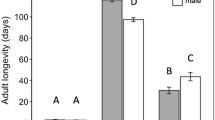Abstract
Eggs of elm beetle,Pyrrhalta luteola (Muller), normally occur in masses which can be viewed as discrete host patches in space and time. Analysis of>800 egg masses from 3 field sites in northern California revealed that the number of eggs/mass varied from 2 to>40 and that the imported egg parasiteTetrastichus gallerucae (Fonsc.) exploited a relatively large proported of the egg masses at certain times. The spatial relationship between parasitization and number of eggs/egg mass was assessed in 2 ways-i.e., for exploited masses only and for all masses combined (exploited+nonexploited). Percent parasitization was density independent in most cases for both data sets. It is suggested that both methods of analysis can provide patterns which are relevant to biological control of insect pests.
Résumé
Les œufs de la Galéruque de l'Orme,Pyrrhalta luteola (MULLER) sont déposés normalement en paquets visibles sous forme de plaques d'hôtes discrètes dans l'espace et dans le temps. L'analyse de plus de 800 plaques issues de trois localités du Nord de la Californie révèle que le nombre d'œufs/plaque varie de 2 à plus de 40 et que le parasite oophage importéTetrastichus gallerucae (FONSC) exploite une proportion relativement grande des plaques d'œufs à certaines périodes.
La relation spatiale entre le parasitisme et le nombre d'œufs/plaque s'estime de 2 façons différentes: par les plaques exploitées uniquement ou par toutes les plaques combinées, qu'elles soient attaquées ou non. Le pourcentage de parasitisme est indépendant de la densité dans la plupart des cas.
On suggère que les 2 méthodes d'analyse peuvent fournir des modèles qui son applicables dans la lutte biologique contre les ravageurs.
Similar content being viewed by others
References
Chesson, J. — 1982. Estimation and analysis of parasitoid search and attack parameters from field data. —Environ. Entomol., 11, 531–537.
Chesson, P. L. &Murdoch, W. W. — 1986. Aggregation of risk: relationships among host-parasitoid models. —Am. Nat., 127, 696–715.
Hassell, M. P. — 1982. Patterns of parasitism by insect parasitoids in patchy environments. —Ecol. Entomol., 7, 365–377.
Hassell, M. P. — 1984. Parasitism in patchy environments: inverse density dependence can be stabilizing. —IMA J. Math. Appl. Med. Biol., 1, 123–133.
Heads, P. A. &Lawton, J. H. — 1983. Studies on the natural enemy complex of the holly leaf-miner: the effects of scale on the detection of aggregative responses and the implications for biological control. —Oikos, 40, 267–276.
Lessells, C. M. — 1985. Parasitoid foraging: should parasitism be density dependent? —J. Anim. Ecol., 54, 27–41.
Morrison, G., Lewis, W. J. &Nordlund, D. A. — 1980. Spatial differences inHeliothis zea egg density and the intensity of parasitism byTrichogramma spp.: an experimental analysis. —Environ. Entomol., 9, 79–85.
Morrison, G. &Strong, D. R. — 1980. Spatial variations in host density and the intensity of parasitism: some empirical examples. —Environ. Entomol., 9, 149–152.
Morrison, G. &Lewis, W. J. — 1984. Inferring parasitoid searching behavior from host mortality data: a note of caution. —Environ. Entomol., 13, 7–14.
Murdoch, W. W., Reeve, J. D., Huffaker, C. B. &Kennett, C. E. — 1984. Biological control of olive scale and its relevance to ecological theory. —Am. Nat., 123, 371–392.
Murdoch, W. W., Chesson, J. &Chesson, P. L. — 1985. Biological control in theory and practice. —Am. Nat., 125, 344–366.
Reeve, J. D. &Murdoch, W. W. — 1985. Aggregation by parasitoids in the successful control of the California red scale: a test of theory. —J. Anim. Ecol., 54, 797–816.
Summy, K. R., Gilstrap, F. E. &Hart, W. G. — 1985.Aleurocanthus woglumi [Hom.: Aleyrodidae] andEncarsia opulenta [Hym.: Encyrtidae]: density-dependent relationship between adult parasite aggregation and mortality of the host. —Entomophaga, 30, 107–112.
Weis, A. E. — 1983. Patterns of parasitism byTorymus capite on hosts distributed in small patches. —J. Anim. Ecol., 52, 867–877.
Author information
Authors and Affiliations
Rights and permissions
About this article
Cite this article
Ehler, L.E., Bugg, R.L., Hertlein, M.B. et al. Patch-exploitation patterns in an egg parasite of elm leaf beetle. Entomophaga 32, 233–239 (1987). https://doi.org/10.1007/BF02373245
Received:
Accepted:
Issue Date:
DOI: https://doi.org/10.1007/BF02373245




